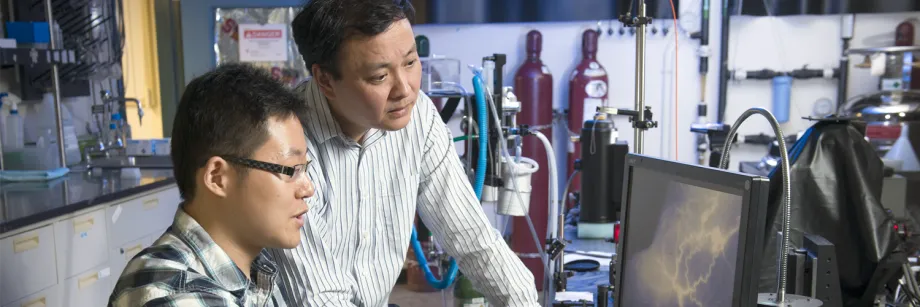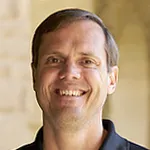
Photo by L.A. Cicero: Graduate student Guosong Hong and professor Hongjie Dai view the vascular structures in a mouse model of arterial disease using near-infrared II fluorescence imaging.
Stanford Neurosciences Institute News - May 1st, 2015 - by Amy Adams
Two Stanford University faculty members developing techniques for monitoring neurons as they fire signals throughout the brain got a boost in the first round of funding by California’s neuroscience research grants program, Cal-BRAIN.
Both projects could help neuroscientists better understand how the brain learns and remembers, or probe what goes awry in mental health conditions, neurodegenerative diseases and other conditions.
Observing the brain
One award went to Nicholas Melosh, associate professor of materials science and engineering and of photon science, who has been refining the electrodes neuroscientists use to record the activity of single neurons. Current electrodes have flat surfaces that don’t latch on well to the cell membrane – even in a relatively stable lab dish the neurons either wiggle away or other cells push the electrodes aside.
Melosh thinks electrodes with a better shape or made of different materials might latch on more strongly to neurons either in a dish or in the living brain. “We want to develop electrodes that would fuse into the cell itself to provide a strong connection,” he said.
Melosh also co-leads the NeuroFab initiative under the Stanford Neurosciences Institute that will serve as an incubator for bringing engineering and nanotechnology to bear on questions in neuroscience.
The second award went to Hongjie Dai, professor of chemistry, who will be developing better technologies for observing neurons as they fire inside the brain. In his recent work, Dai was able to image the brain of a mouse through the animal’s skin and skull. That work used fluorescence in the near infrared wavelengths, up to 1700 nanometers. With the new funding he hopes to develop advanced sensors that can be seen through several millimeters of brain tissue.
“We plan to develop new types of fluorescence agents so that we can go deeper into the brain to glean neuron activity,” said Dai, who is also the J.G. Jackson and C.J. Wood professor in chemistry.
Both Dai and Melosh are members of Stanford Bio-X, which bridges disciplines to advance biomedical discovery.
California research funding
Cal-BRIAN, or California Blueprint for Research to Advance Innovations in Neuroscience, was signed into law in 2014 by Governor Jerry Brown as a way of bolstering research at the intersection of engineering and neuroscience. The program’s relatively small grants of $120,000 are expected to help California scientists compete for funding from the national BRAIN initiative announced by US President Barack Obama in April 2013. The National Institutes of Health, National Science Foundation and Defense Advanced Research Projects Agency have all committed money to the initiative.
William Newsome, Vincent V.C. Woo Director of the Stanford Neurosciences Institute, co-led the BRAIN initiative working group and says Cal-BRAIN is a good complement to the national program.
“Cal-Brain will help establish California's preeminence in neuroscience research by supporting the efforts of our most creative researchers to probe the mysteries of the brain,” said Newsome, who is also the Harmon Family Provostial Professor and professor of neurobiology. “A neurotech industry will undoubtedly grow from the cutting edge technologies being developed to investigate the nervous system and treat neural injury and disease.”
Cal-BRAIN received $2 million in initial funding from the state, most of which went to this round of 16 Seed grants to 13 California institutions. The remaining funds are for administrative costs and scientific meetings. Unlike the national initiative, Cal-BRAIN is charged with developing relationships with industry that will translate discoveries into commercial applications.
“This funding a great way to leverage the things we’ve been working on and try to push it toward something that will make an impact for a clinical device,” said Melosh.
Originally published at Stanford Neurosciences Institute News



